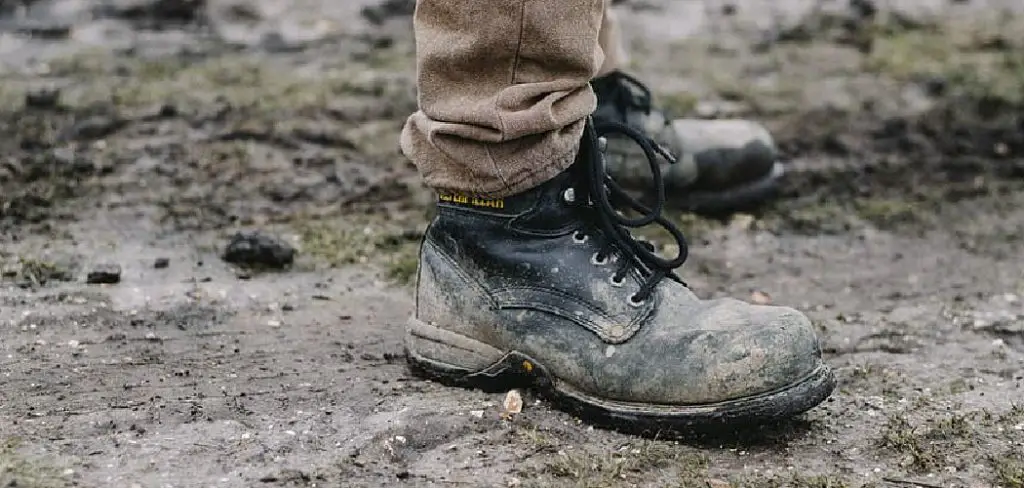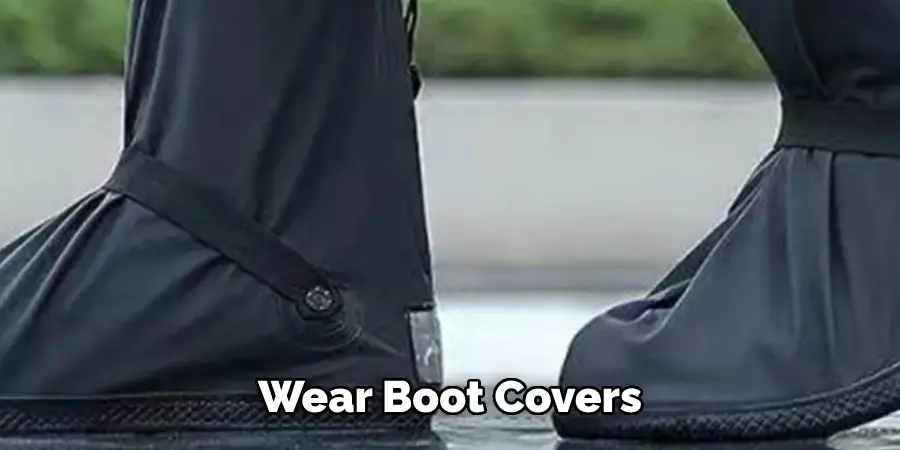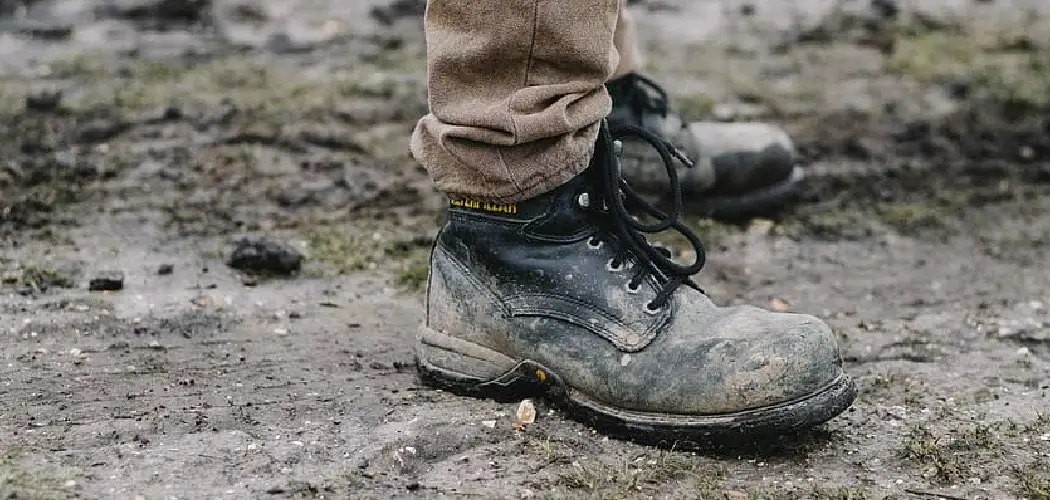Keeping your work boots clean not only maintains their appearance, but also helps prolong their lifespan. Dirt and debris can accumulate on the boots, damaging the materials and causing them to wear out faster. Cleaning your work boots regularly can prevent this and ensure that they continue to protect your feet while working.

The main purpose of cleaning your work boots is to ensure that they last long. No one wants to spend their hard-earned money on a piece of gear that will only serve them for a short period of time. Research shows that a well-maintained pair of work boots can last up to twice as long as those that are not properly cleaned and maintained. You can find step-by-step instructions on how to clean work boots in this blog article.
Step-by-step Instructions for How to Clean Work Boots
Step 1: Inspect Your Work Boots
Before you start cleaning your work boots, it is important to inspect them and identify any areas that need special attention. Look for any dirt, grime, or stains on the surface of the boots. Also, check the stitching and seams for any signs of wear and tear.
Step 2: Remove Laces and Insoles
Take out the laces and insoles of your work boots. This will make it easier for you to clean the entire surface of the boots, including the tongue and eyelets. Use a soft-bristled brush or an old toothbrush to gently brush off any loose dirt and debris from your work boots. Make sure to remove as much dirt as possible before moving on to the next step.
Step 3: Prepare Cleaning Solution
In a small bowl, mix together warm water and a mild detergent or soap. You can also use a specialized boot cleaner if you have one. Avoid using harsh chemicals or bleach as they may damage the material of your work boots.

Dip the brush or toothbrush into the cleaning solution and start scrubbing your work boots. Pay extra attention to any stained or dirty areas. If your boots are made of leather, be sure to use a soft-bristled brush to avoid scratching the surface.
Step 4: Rinse with Clean Water
After you have thoroughly scrubbed your work boots, rinse them with clean water. Make sure to remove all the soap residue and dirt.
or paper towels to dry off your work boots. Avoid using a hairdryer or placing them in direct sunlight as this can cause the material to crack or become discolored.
Step 5: Apply Leather Conditioner (Optional)
If your work boots are made of leather, you can apply a leather conditioner to keep them soft and supple. This will also help protect them from water and other elements. Once your work boots are completely dry, you can reinsert the laces and insoles. If they have become worn out or damaged, it may be time to replace them with new ones.
Step 6: Store Your Clean Work Boots
Finally, store your clean work boots in a cool and dry place. Avoid storing them in plastic bags or airtight containers as this can cause mold and mildew to grow. Instead, use a shoe tree or stuff them with newspaper to help maintain their shape.

Remember to clean them regularly, especially if you wear them for long hours or in harsh environments. This will not only help prolong their lifespan but also ensure that they remain comfortable and perform at their best.
Precautions for How to Clean Work Boots
- Wear protective gear such as gloves, eye protection and a mask to avoid inhaling harmful chemicals.
- Work in a well-ventilated area to minimize exposure to chemicals or fumes.
- Always read the instructions on the cleaning products carefully before use and follow them accordingly.
- Test any new product on a small inconspicuous area of your boots first to ensure it does not cause any damage.
- Avoid mixing different chemicals together, especially bleach and ammonia as they can produce toxic fumes.
- Use a soft-bristled brush or cloth to gently remove dirt and stains from your work boots. Harsh scrubbing can damage the material or finish of your boots.
- After cleaning, rinse off any residue with clean water and allow your boots to air dry completely before wearing them again.
By following these precautions, you can ensure a safe and effective cleaning process for your work boots. Remember to always prioritize your safety while taking care of your work gear.

Factors that Determine the Frequency of Cleaning Work Boots
The frequency of cleaning work boots depends on various factors such as:
- Nature of work: The type of work you do plays a significant role in determining how often you should clean your work boots. If you work in a dirty or dusty environment, you may need to clean your boots more frequently than someone who works in a cleaner setting.
- Weather conditions: Extreme weather conditions can also affect the frequency of cleaning your work boots. For instance, if you work outdoors and encounter muddy or wet conditions, you may need to clean your boots more frequently.
- Sweat and odor: If your feet tend to sweat a lot or produce an unpleasant odor, you may need to clean your work boots more often to prevent the buildup of bacteria and fungi that can cause foot infections.
- Material of the boots: The material of your work boots can also determine how often they should be cleaned. For example, leather boots may require more frequent cleaning compared to synthetic or rubber boots.
- Personal preference: Each person may have their own standards for cleanliness and may prefer to clean their work boots more or less frequently based on personal preferences.
By considering these factors, you can determine how often your work boots need to be cleaned. But as a general rule, it is recommended to clean them at least once a month.
How Can You Prevent Your Work Boots From Getting Dirty in the First Place?
While cleaning your work boots regularly is essential, there are also steps you can take to prevent them from getting dirty in the first place. Here are some tips:
- Wear boot covers: If you work in a particularly dirty environment, consider investing in boot covers to protect your boots from excess dirt and debris.
- Use protective sprays: There are various protective sprays available for different types of work boots that can help repel dirt and water, keeping your boots cleaner for longer.
- Keep your work area clean: By regularly cleaning your work area, you can reduce the amount of dust and debris that may accumulate on your boots.
- Avoid unnecessary contact with dirty surfaces: Be mindful of where you step and try to avoid walking through mud or puddles unnecessarily.

By taking these preventive measures, you can prolong the time between cleanings and keep your work boots in better condition for longer. Ultimately, the frequency of cleaning your work boots will depend on your specific circumstances and personal preferences.
Are There Any Special Considerations When Cleaning Leather Work Boots?
Cleaning leather work boots requires special care in order to maintain their quality and prolong their lifespan. In this section, we will discuss some important considerations to keep in mind when cleaning your work boots. Firstly, it is essential to use the right products for cleaning leather work boots. Avoid using harsh chemicals or solvents as they can damage the leather and cause discoloration. Instead, use a leather cleaner specifically designed for boots or gentle soap and water.
Secondly, make sure to remove any excess dirt or debris from your work boots before cleaning them. This can be done by gently brushing off the surface with a soft-bristled brush or wiping them down with a damp cloth. When cleaning the leather, it is important to test the product on a small, inconspicuous area first to ensure it does not cause any harm. This will give you the opportunity to assess any potential reactions before applying the product to the whole boot.
Is There a Specific Technique for Cleaning Work Boots?
Work boots are an essential part of many jobs, providing protection and support for the feet throughout the day. However, due to their constant use in potentially dirty or hazardous environments, work boots can quickly become dirty and even smelly. To ensure that your work boots remain in good condition and last as long as possible, it is important to know how to properly clean them.
First and foremost, it is essential to follow any manufacturer instructions for cleaning your specific type of work boots. These instructions may vary depending on the materials used in your boots, such as leather or synthetic materials. If you no longer have access to these instructions, do not worry, as there are general cleaning techniques that can be applied to most work boots.
Before starting the cleaning process, it is important to remove any loose dirt or debris from your boots. This can be done by gently brushing them with a soft-bristled brush or wiping them down with a damp cloth. Next, you will need to remove the laces and insoles from your boots. Laces can be easily cleaned by soaking them in warm water and a gentle detergent, while the insoles can be washed separately or replaced if necessary.
Conclusion
In conclusion, knowing to clean work boots can save you time, money and keep your boots in great condition for a long period of time. By following these simple steps, you can ensure that your work boots continue to provide the necessary protection and support while also looking clean and presentable.
It is important to remember that regular cleaning of work boots is essential to maintain their durability and longevity. Neglecting to clean your work boots can lead to buildup of dirt, debris and stains that not only make them look unattractive but also weaken the material. I hope this article has been beneficial for learning how to clean work boots. Make Sure the precautionary measures are followed chronologically.

